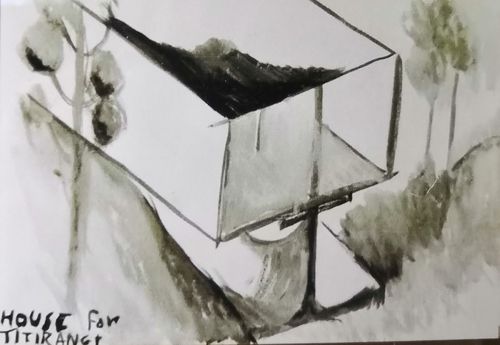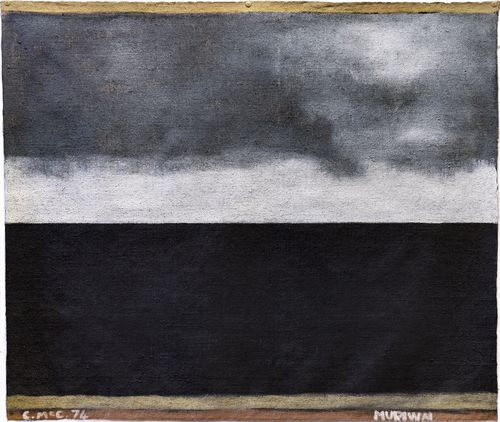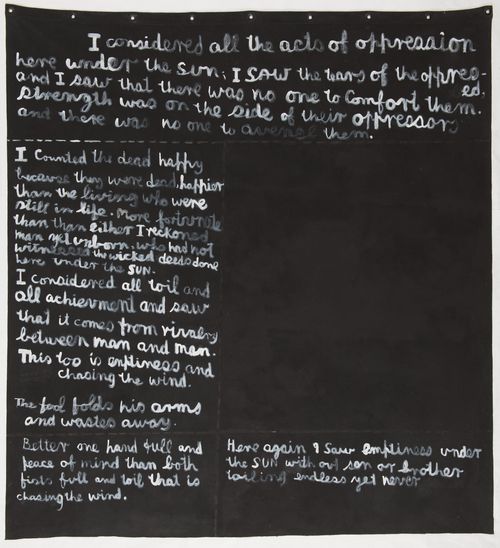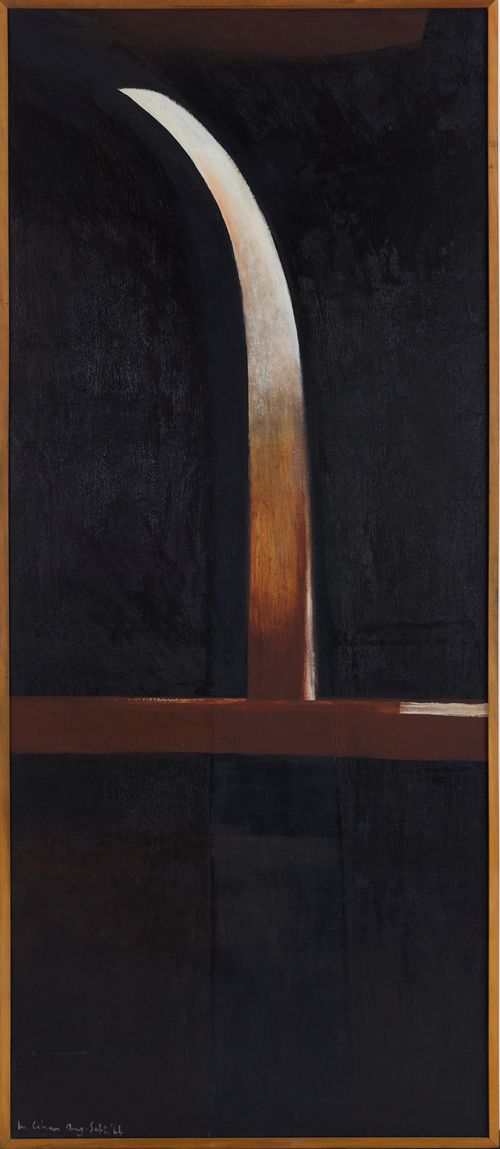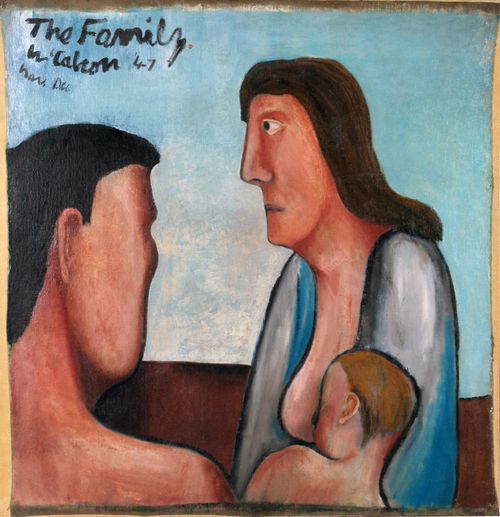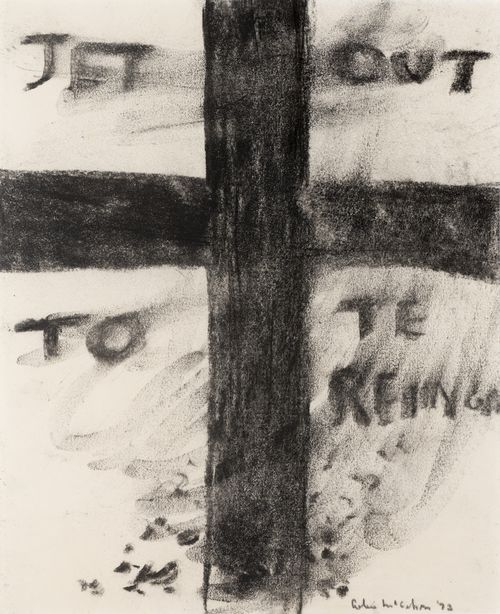Muriwai no.7

Muriwai no. 7, 1969, sand, synthetic polymer paint on hardboard, 280 x 290 mm. Private collection, courtesy McCahon Research and Publication Trust

Harold Jones, In Autumn or in Spring, poem published in New Zealand Books, Pukapuka Aotearoa, summer 2017.
Harold Jones
Memories of Colin McCahon
I was 17, a boarder at Dilworth School, Auckland, when I met Colin McCahon. Perhaps unusually, I then came to enjoy his artistic comment and guidance for an hour or so at a time, once a fortnight, over a period of several months. The year would be 1969.
The period of this association began, I think, after I had work accepted for the Auckland Secondary Schools Art Exhibition. Garth Tapper, an old boy of the school, and then holding a teaching position at Elam, came to visit, and asked to see more of my work. Perhaps someone, a master, at the school had spoken to him. There wasn’t much of it to show. For me, it was an escape from the various confines and routines of my schooling. It was something of my own, pursued in reveries of independence, quiet and imagination.
However, Garth decided he’d like to come to the school occasionally and give me his tuition or guidance. On one of these occasions, early on, he brought with him a man he introduced as Colin McCahon.
I remember Colin personally as someone of unusual nervous intensity, often lighting or putting out a cigarette as he sat, somewhat coiled, and looked at things and talked. Smallish, dark. Direct. Engaged and yet somewhat remote. There was always an ashtray to empty.
At this beginning, I didn’t know anything much – really anything at all – about him or his work. That, I have since reasoned, was to my distinct advantage. After this introduction, he and Garth came together several times, once a fortnight as I remember, after school. We met in a small music room I had been allowed to convert into a studio. It filled, pleasingly, with cigarette smoke.
They enjoyed talking together about Elam, disparaging it humorously with each other. Teaching there was something they had to do. I was a bit shocked. It was, they assured me, no place to aspire to. They had a kind of banter, which they obviously both enjoyed, talking ‘off the premises’.
Colin tended to draw or sketch loosely in support of what he was saying. On one occasion, he made quite a full drawing in illustration of a point in discussion. Garth commented, “you should sign that”. Colin made no response, but I could see the suggestion wasn’t welcome and that Garth regretted it.
After a while, Garth dropped off, and Colin continued to come on his own, arranging to visit me at the school, giving me work to undertake, and then discussing it with me. I remember a few distinct occasions of his intense interest. One – the first I think – was his keen questioning of me regarding a pen and ink sketch of a school building. Why, he asked, was a shadowed entrance area (a kind of inset doorway) so dark, so black? He asked this several times. I had no better answer than to say that’s how it looked. I remember this pleased him.
Most often, as I recall, he had me painting my coffee mug (a duck-egg pottery thing with a very low handle) with pieces of fruit. These would be in oil. Usually, I painted between his visits. On occasions, I painted with him there, while he sat and smoked and watched and commented. The mug, he said, was man-made. The orange or apple was a natural object. Now they were all made again. What had I made? I had no idea. A picture of them? A painting? An exercise? I stared at my work. What had I made? Who knew?
On another occasion, I had made a contact print of a head – imagined, not a portrait – between his visits, in black ink, and applied four or five words in the lower left corner. I had cut them out of headlines in a magazine and put them together on two lines.
The words made no kind of rational sentence or statement. Colin fastened on these. Why had I done this? What were they about? What did they mean? I just thought they belonged there. But why? I had no better response. They seemed to be needed right there, in that place. But this was a question he wasn’t willing to let go. The conversation went round in circles and we gave up. (Since that time, I have sometimes thought that this work was the only thing approaching an art object that I have made.)
Words, in fact, were of increasing interest to me. I was awarded second prize in an NZBC national poetry competition celebrating the bicentenary of Cook’s visit in 1769. How did I choose the words? He asked this. What was it like for me writing in this way, adding words and lines in a poem? How did I answer? I don’t remember.
Late in our association – can a naïve schoolboy call it a friendship? – I was talking with him about poetry or painting, as if I had a career choice between them. Elam was out. That was certain. I remember him saying it would do me no good. It wouldn’t be good for me. He may have said, stick with poetry. And that was that. I was sacked. I left school at the end of the year.
And Colin? Well, in 1969 he would, as I’ve since learned, been returning to his investigations of Muriwai. So I’ve chosen one of these works to accompany my memories of him.
A Personal Postscript
I did stick with poetry. A few years later I had a book of poems published in England which was well received, notably by Ted Hughes, and after invitation and examination I was awarded an Entrance Exhibition to read English at Cambridge University.
